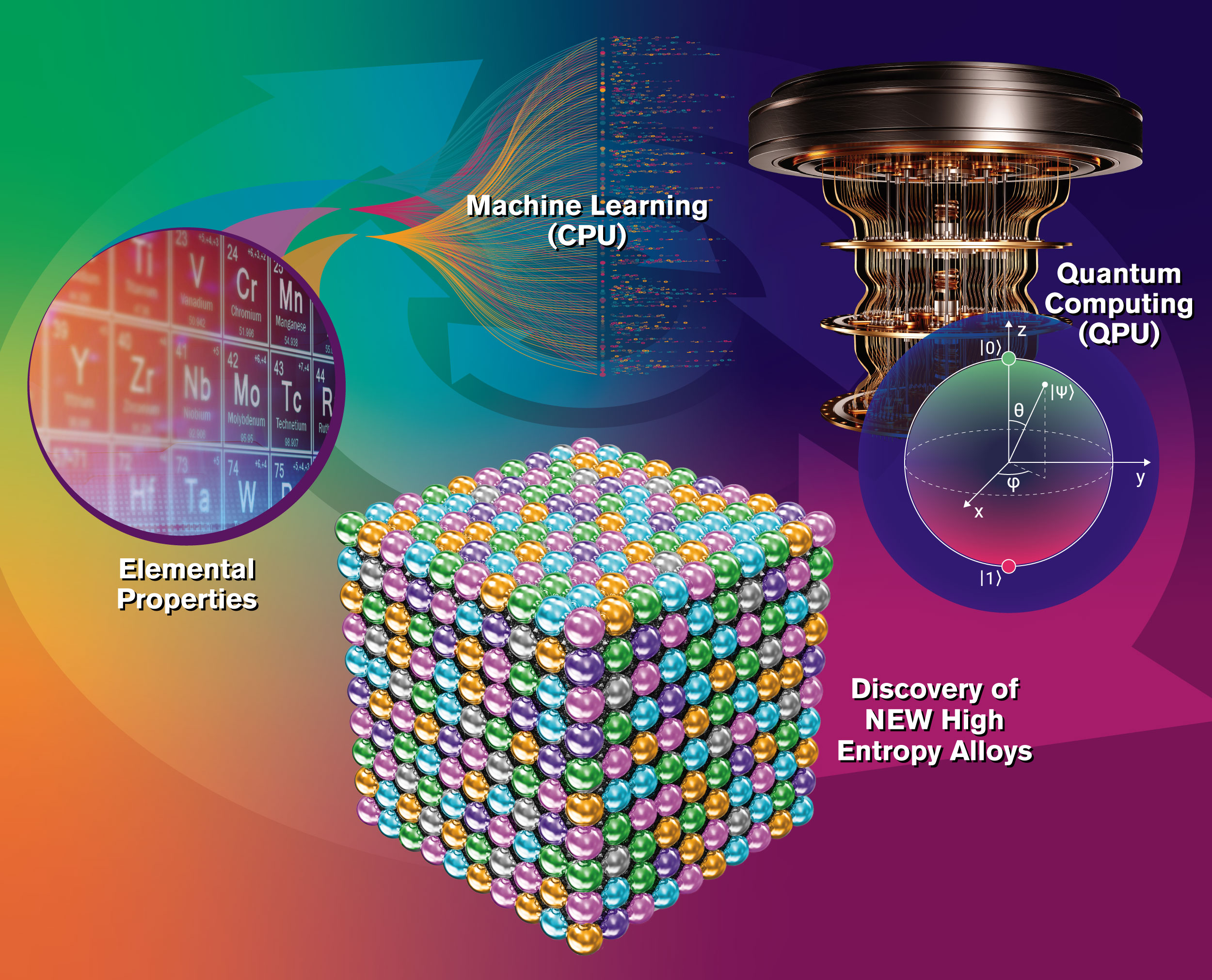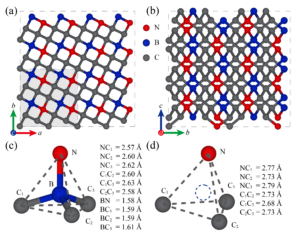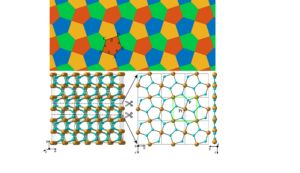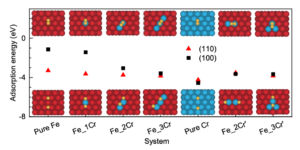Quantum Mechanical Engineering Laboratory at ASU
Research Interests: Quantum Simulations, Machine Learning, and Quantum Computing

Design of High-Entropy Materials via Classical and Quantum Computers
We have been applying classical and quantum computers for machine learning and multi-scale atomic simulations to design high-entropy Materials (HEMs) for various applications. Our recent efforts show that Si-Ge-Sn alloys serve as a prototype example of semiconducting HEMs, exhibiting unique electrical and thermal transport properties, which endow these complex materials systems with potential to be novel room-temperature thermoelectric materials.

Selected Publications:
- Quantum machine-learning phase prediction of high-entropy alloys
P. Brown and H. L. Zhuang
Materials Today, 63, 18 (2023). [doi:10.1016/j.mattod.2023.02.014] - Sudoku-inspired high-Shannon-entropy alloys.
H. L. Zhuang
Acta Materialia, 225, 117556 (2022). [doi:10.1016/j.actamat.2021.117556] - From evidence to new high-entropy alloys
H. L. Zhuang
Nature Computational Science, 1, 458 (2021). [doi:10.1038/s43588-021-00100-4] - Electrical and thermal transport properties of medium-entropy SiyGeySnx alloys.
D. Wang, L. Liu, M. Chen, and H. L. Zhuang
Acta Materialia, 199, 443 (2020). [doi:10.1016/j.actamat.2020.08.053] - Machine-learning phase prediction of high-entropy alloys.
W. Huang, P. Martin, and H. L. Zhuang
Acta Materialia, 169, 225 (2019). [doi:10.1016/j.actamat.2019.03.012] - Semiconducting SiGeSn high-entropy alloy: A density functional theory study.
D. Wang, L. Liu, W. Huang, and H. L. Zhuang
Journal of Applied Physics, 126, 225703 (2019). [doi:10.1063/1.5135324] - Machine learning for phase selection in multiprincipal element alloys.
N. Islam, W. Huang, and H. L. Zhuang
Computational Materials Science, 150, 230 (2018). [doi:10.1016/j.commatsci.2018.04.003]
Computational Design and Discovery of Novel Quantum Materials for Quantum Computers
Despite its early infancy, quantum computers hold great potential for solving complex problems that are extremely challenging for current supercomputers. These problems range from factorizing a large integer to breaking public-key cryptography to discovering drugs to treat pandemic diseases. At the heart of the quantum computers’ power are the materials that constitute the quantum bits (i.e., qubits), which have two energy levels that are analogous to the classical bits represented by 0s and 1s. To realize the full potential of quantum computers in the foreseeable future, advancing the development of the building blocks of the qubits is key. Among the many proposed candidate materials for constituting qubits, solid-state quantum materials exhibit advantages that can lead to scalable quantum computers in the near future.

Selected Publications:
1. Spin qubit based on the nitrogen-vacancy center analog in a diamond-like compound C3BN.
D. Wang, L. Liu, and H. L. Zhuang
Journal of Applied Physics, 130, 225702 (2021). [doi:10.1063/5.0074320]
2. Stone-Wales defects preserve hyperuniformity in amorphous two-dimensional networks.
D. Chen, Y. Zheng, L. Liu, G. Zhang, M. Chen, Y. Jiao, and H. L. Zhuang
Proceedings of the National Academy of Sciences, 118, e2016862118 (2021). [doi:10.1073/pnas.2016862118]
3. Disordered hyperuniformity in two-dimensional amorphous silica.
Y. Zheng, L. Liu, H. Nan, Z.-X. Shen, G. Zhang, D. Chen, W. Xu, L. He, W. Xu, M. Chen, Y. Jiao, and H. L. Zhuang
Science Advances, 6, eaba0826 (2020). [doi:10.1126/sciadv.aba0826]
From Pentagonal Geometries to Two-Dimensional Quantum Materials
Over a time span of a century, 15 types of pentagons that can tessellate a plane without creating a gap have been discovered by professional and amateur mathematicians with many inspiring stories. For example, Majorie Rice, who never attended college, discovered four types (types 9 and 11-13) pentagons in the 1970s. In honor of her discovery, the floor tiling in the entry foyer of the headquarters of the Mathematical Association of America is based on type 9 pentagon. To explore the applications of these 15 types of pentagons, we use them as building blocks for novel two-dimensional (2D) quantum materials and apply density functional theory calculations to characterize the properties (e.g., magnetic ordering) of these 2D materials.

Selected Publications:
1. From pentagonal geometries to two-dimensional materials.
H. L. Zhuang
Computational Materials Science, 159, 448 (2019). [doi:10.1016/j.commatsci.2018.12.04]
2. Ab initio playing of pentagonal puzzles.
L. Liu, I. Kankam, and H. L. Zhuang
Electronic Structure, 1, 015004 (2019). [doi:10.1088/2516-1075/aae303]
3. Single-layer ferromagnetic and piezoelectric CoAsS with pentagonal structure.
L. Liu and H. L. Zhuang
APL Materials, 7, 011101 (2019). [doi:10.1063/1.5079867]
4. Single-layer antiferromagnetic semiconductor CoS2 with pentagonal structure.
L. Liu, I. Kankam, and H. L. Zhuang
Physical Review B, 98, 205425 (2018). [doi:10.1103/PhysRevB.98.205425]
5. PtP2: An example of exploring the hidden Cairo tessellation in the pyrite structure for discovering novel two-dimensional materials.
L. Liu and H. L. Zhuang
Physical Review Materials, 2, 114003 (2018). [doi:10.1103/PhysRevMaterials.2.114003]
Experimental Collaborations on Advanced and Emerging Materials
We welcome experimental collaborations on a wide range of advanced and emerging materials such as corrosion-resistant alloys, two-dimensional materials, and battery materials.

Selected Publications:
1. A percolation theory for designing corrosion resistant alloys
Y. Xie, D. Artymowicz, P. Lopez, D. Wang, A. Aiello, J. Hart, M. Taheri, H. L. Zhuang, R. Newman, and K. Sieradzki
Nature Materials, 20, 789 (2021). [doi:10.1038/s41563-021-00920-9]
2. Abnormal band bowing effects in phase instability crossover region of GaSe1-xTex nanomaterials.
H. Cai, B. Chen, M. Blei, S. L. Y. Chang, K. Wu, H. L. Zhuang, and S. Tongay
Nature Communications, 9, 1927 (2018). [doi:10.1038/s41467-018-04328-z]
3. Electrochemical surface passivation of LiCoO2 particles at ultrahigh voltage and its applications in lithium-based batteries.
J. Qian, L. Liu, J. Yang, S. Liu, H. L. Zhuang, and Y. Y. Lu
Nature Communications, 9, 4918 (2018). [doi:10.1038/s41467-018-07296-6]
4. A ‘cation-anion regulation’ synergistic anode host for dendrite-free lithium metal batteries
W. Zhang, H. L. Zhuang, L. Fan, L. Gao, and Y. Y. Lu
Science Advances, 4, eaar4410 (2018). [doi:10.1126/sciadv.aar4410]
